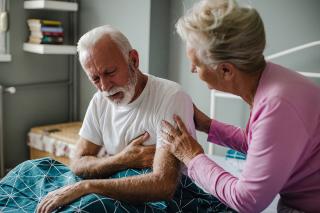Wisdom isn’t the only thing that increases with age. The risk of having a stroke also increases, doubling every ten years after age 55.
Some good news: Stroke deaths have declined over the last decade, even moving down the ranks from the third to fourth spot for the leading cause of death. This remarkable reduction has been attributed to decreased smoking rates and better blood pressure and cholesterol control.
Still, while strokes can occur in people of any age, race, and gender, some people have a disproportionately higher risk. For example, people who are Black, Hispanic, American Indian, and Native Alaskan may be more likely to have a stroke than non-Hispanic Whites or Asians, according to the Centers for Disease Control (CDC). Additionally, women are more likely to have (and die) from a stroke than men. Thus, spotting the warning signs and finding ways to reduce your risk is that much more important.
What is a Stroke?
A stroke, by simple definition, occurs when something (like a clot) blocks the blood supply to part of the brain or when a blood vessel in the brain bursts. As a result of the brain not receiving the blood and oxygen it needs, parts of the brain become damaged or die, causing lasting brain damage, long-term disability, or even death. For seniors, surviving a stroke can mean living with paralysis, vision loss, memory loss, speech and language problems, and behavioral changes that make everyday tasks challenging, such as eating, dressing, grooming, and walking.
Spotting Stroke Warning Signs: Act FAST
The acronym FAST can help anyone remember the warning signs of a stroke and serve as a reminder to act quickly as soon as the warning signs are spotted. With a stroke, every minute counts.
Face: During a stroke, the face may appear to droop on one side, or their smile may look uneven. Ask them to smile if you suspect a stroke.
Arm: Weakness or numbness in one or both arms is not uncommon during a stroke. Ask them to raise one or both arms. Does one drift down?
Speech: Speech is often slurred and hard to understand during a stroke. Ask the person to repeat a short sentence. Do they repeat it correctly and understandably?
Time: Every second counts. Call 911 at the first sign of a stroke.
Questions to Ask if You Suspect Someone is Having a Stroke
Knowing the most common symptoms and which questions to ask a loved one you suspect may be having a stroke can save their life or prevent irreversible brain damage.
Headache
“Is this headache unlike anything you’ve experienced? Is this the worst headache you’ve ever had?”
Vision
“Has there been a sudden change in your vision? Are you seeing double?”
Weakness or numbness on one side of body
“Can you raise both arms? Are you unable to move one side of your body? Can you feel my touch?”
Slurred speech
“Can you repeat after me? The sun is shining.” (You can ask them to repeat any short, simple sentence.)
Treatment and Recovery for Stroke Patients
Evidence shows that early admission to the hospital can reduce mortality and improve functional outcomes. This is particularly important within the first couple of months following a stroke when recovery is at its greatest potential.
Once admitted, the emergency team will move very quickly, administering a CT scan and other imaging tests or ultrasounds as needed. They will also make a prognosis based on the type, amount, and location of the stroke, the patient’s age, whether or not it was the first stroke occurrence, preservation of sensation in the affected side, early motor recovery of affected limbs, early recovery of bowel and bladder control, patient motivation, absence of depression or cognitive impairments, and good family or social support.
Then the appropriate facility, whether an acute inpatient rehab or nursing home, should be chosen based on the assessment of the patient’s needs, services required, and medical stability. Your doctor will recommend the most robust therapy program you can handle in hopes of full recovery. That said, everyone’s recovery is different and your treatment team may include:
- Neurologist
- Physiatrist (rehabilitation doctor)
- Rehabilitation nurse
- Dietitian
- Physical therapist
- Occupational therapist
- Recreational therapist
- Speech pathologist
- Social worker
- Case manager
- Psychologist
- Psychiatrist
Reducing Your Risk of Stroke: What You Can Do
Evidence suggests strokes can be prevented with healthy lifestyle changes and working closely with your doctor to manage any health conditions that increase your risk of stroke. Here’s how you can take action and keep your cognitive health in good order:
- Eat a healthy diet full of nutrient-dense whole foods, vegetables, fruit, and healthy fats
- Exercise daily (even 20-30 minutes of walking)
- Keep a healthy weight (being overweight or obese increases your risk of stroke)
- Don’t smoke
- Limit or avoid alcohol consumption
- Check your cholesterol routinely
- Lower your blood pressure
- Control your diabetes
- Take medicine as directed, and do not stop without talking to your doctor or pharmacist

